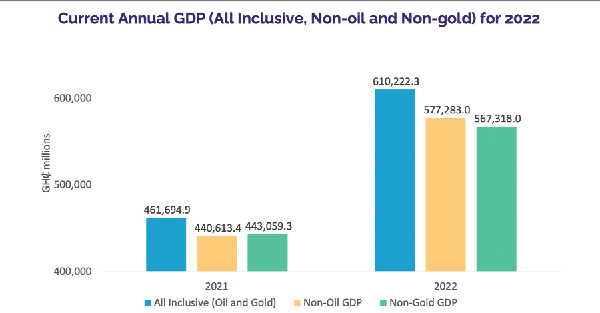The value of Ghana’s economy grew from GH¢461.69 billion in 2021 to GH¢610.22 billion in 2022, provisional estimates from the Ghana Statistical Service has indicated.
This represents a growth of 3.1 per cent which is slower than the growth of 5.1 per cent recorded in 2021.
The 3.1 per cent growth is lower than the government’s projected growth of 3.7 per cent in the 2023 budget.
It is also lower than forecasts from the International Monetary Fund, the World Bank and the African Development Bank which projected a GDP growth of 3.6 per cent, 3.5 per cent and 3.6 per cent respectively.
Non-oil GDP grew by 3.8 per cent in 2022, compared to 6.6 per cent in 2021, while non-gold GDP also grew 2.1 per cent in 2022, compared to 7.1 per cent in 2021.
Ghana’s 2022 GDP growth compares favourably with some of its peers on the continent, with Nigeria, Tunisia and South Africa, recording annual GDP growths of 3.1 per cent, 2.4 per cent and two per cent respectively.
Countries such as Mauritius, Rwanda, Botswana and Namibia,however, recorded higher GDP rates of 8.7 per cent, 8.2 per cent, 5.8 per cent, 4.6 per cent respectively.
Presenting the GDP figures, the Government Statistician, Professor Samuel Kobina Annim, said the services sector continued to dominate GDP growth, contributing 44.9 per cent of the value of the economy in 2022.
This was followed by the industry sector with 34.2 per cent and the agriculture sector with 20.9 per cent.

Sector growth
The services sector grew by 5.5 per cent in the year under review, with the information and communication sub sector recording the highest year on year GDP growth rate of 19.7 per cent.
This was followed by education (10.2 per cent); health and social work (9.2 per cent); public administration, defence and social security (6.1 per cent); financial and insurance activities (5.7 per cent); transport and storage (4.7 per cent); and trade, repair of vehicles, household goods (1.3 per cent).
Some of the sub sectors which contracted include hotels and restaurants (-1 per cent); other personal service activities (-1.3 per cent); real estate (-7.6 per cent) and professional, admin and support services (-10.9 per cent).
The industry sector also grew by 0.9 per cent in the year under review, with the mining and quarrying sub sector recording the highest year on year annual GDP growth rate of 8.1 per cent.
All the other sub sectors contracted in 2022. The manufacturing sub sector contracted by 2.5 per cent, the electricity sub sector contracted by 3.3 per cent, the construction sector contracted by four per cent and the water and sewerage sub sector also contracted by 4.9 per cent.
The agriculture sector on the other hand also grew by 4.2 per cent in 2022, with the fishing sub sector recording the highest year on year growth rate of 8.8 per cent.
This was followed by the livestock sub sector (5.5 per cent); crops (3.8 per cent) and forestry and logging (1.7 per cent).
Comments